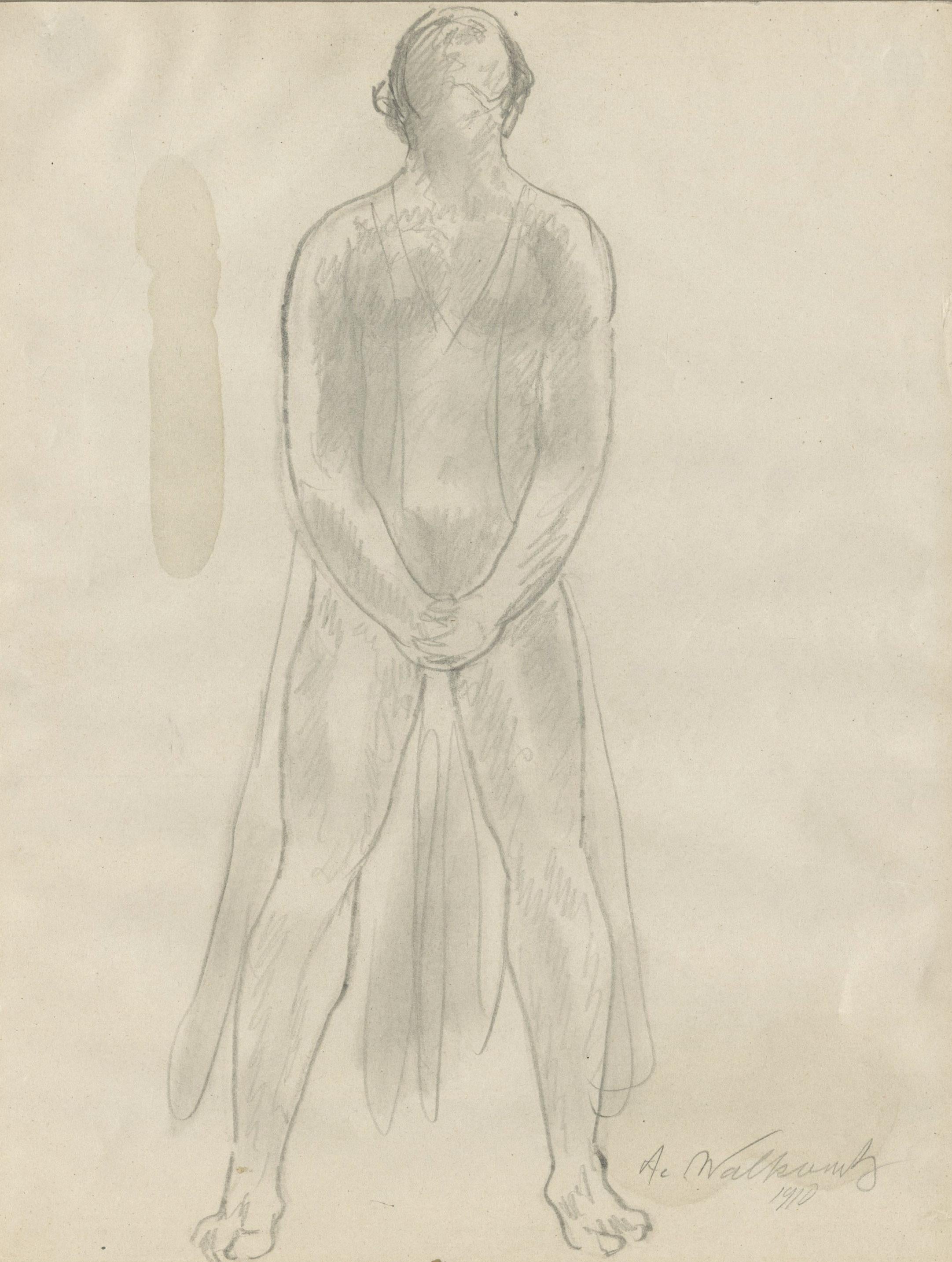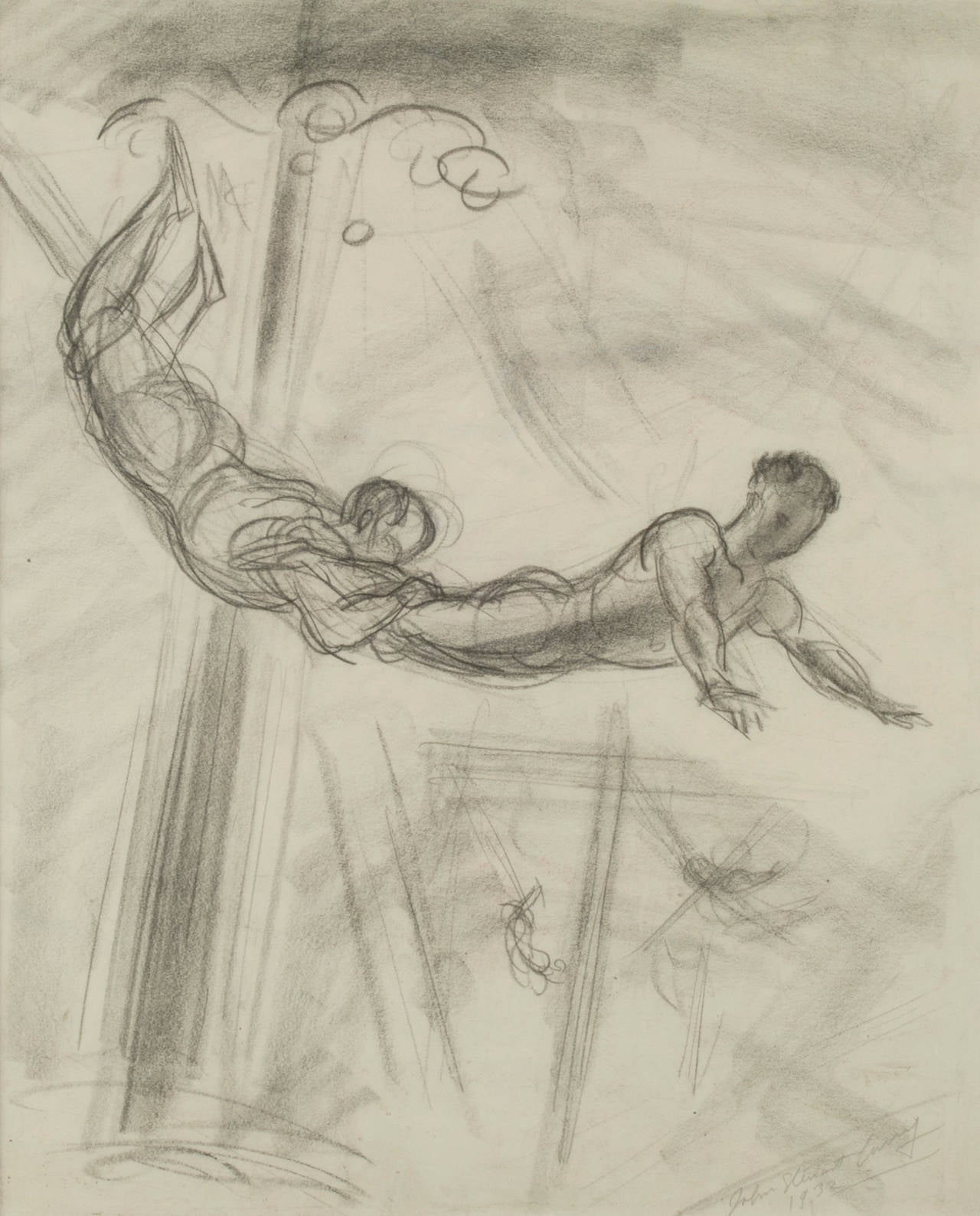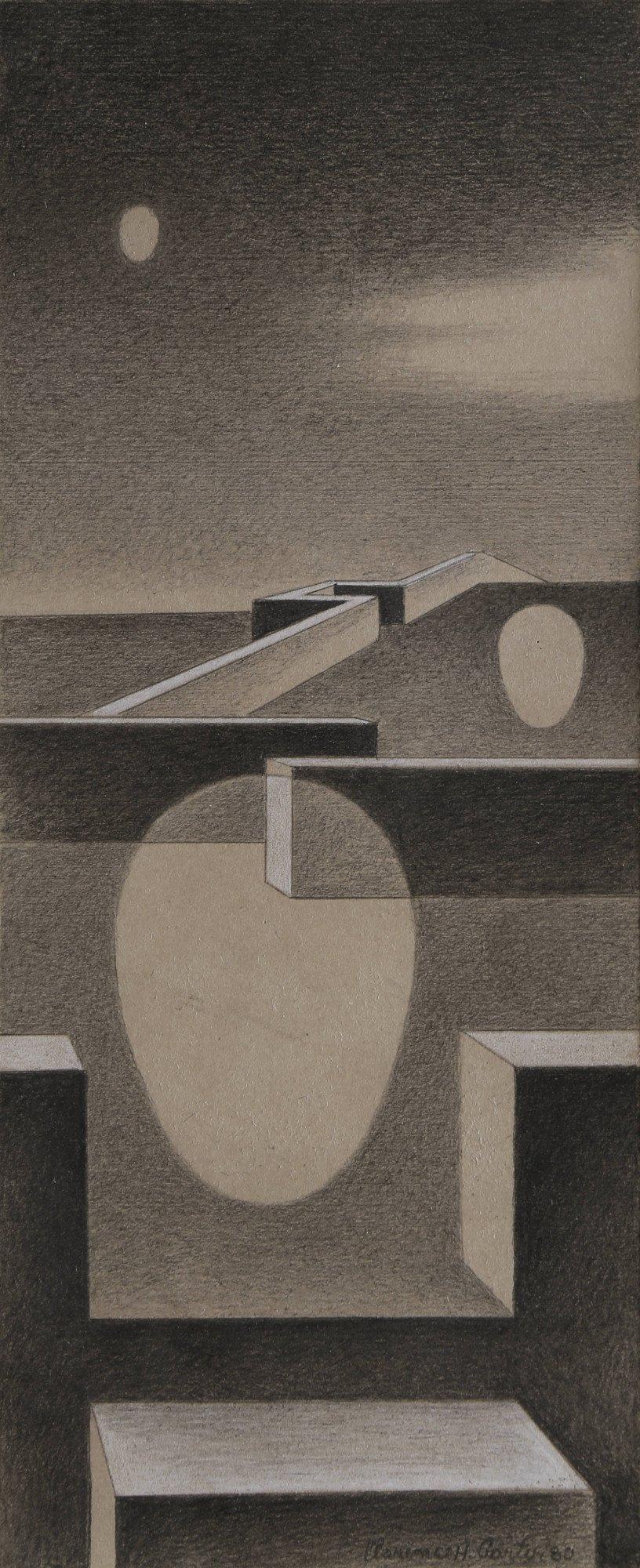Items Similar to Seated Couple
Want more images or videos?
Request additional images or videos from the seller
1 of 11
Raphael SoyerSeated Couplec. 1967
c. 1967
About the Item
Inspiration (Seated Couple)
Graphite on paper, c. 1967
Signed twice in pencil by the artist on recto (see photos)
Condition: Excellent
Image size: 13 x 16 inches
Note: Although not titled, this drawing has strong resemblance to a 1967 lithograph entiteld Man and Wife, depicting Irwin Hollander and his wife. See Raphael Soyer: Sixty-five Years of Printmaking, No. 99, page 63 for description and illustration of the lithograph. Hollander was a noted contract printer and printed many of Soyer's lithographs. (see photo of related lithograph)
Provenance:
Cecille Pulitzer, St. Louis, former member of the Library of Congress Trust Board and a member of the famous St. Louis publishing family
Raphael Soyer
1899-1987
Russian-born artist Raphael Soyer is best known for his compassionate, naturalistic depictions of urban subjects. His sensitive, penetrating portrayals include a broad range of city dwellers: Bowery bums, dancers, seamstresses, shoppers, office workers and fellow artists. Historically, Soyer is associated with the social realist artists of the 1930s, whose art championed the cause of social justice.
Born in Tombov, Russia in 1899, Soyer emigrated with his family to the United States in 1912. His siblings included a twin brother, Moses, and a brother, Isaac, who became successful artists. After settling with his family in New York City, the young Soyer pursued an art education at Cooper Union from 1914 to 1917, at the National Academy of Design from 1918 to 1922, and intermittently at the Art Students League.
Soyer was referred to as an American Scene painter. He is identified as a Social Realist because of his interest in men and women viewed in contemporary settings which included the streets, subways, salons and artists' studios of New York City, although he avoided subjects that were particularly critical of society. He also wrote several books on his life and art.
Soyer's earliest work was consciously primitive in manner. Until the late 1920s, he typically used frontal presentations, shallow pictorial space and figures rendered in caricature. Later, he developed a brushy, more gestural style that was tonal rather than coloristic. These early works are reminiscent of the paintings of Edgar Degas.
Soyer's interest in depicting his urban environment was expressed early in his career in works such as Sixth Avenue (ca. 1930-1935, Wadsworth Atheneum). As the Depression continued, the artist turned more and more to subjects directly related to the prevailing economic difficulties. One result of the mass unemployment of the 1930s that caught Soyer's imagination was the new role of independent working women. Hemmed in by the crowd, the self-absorbed women in Office Girls (1936, Whitney Museum of American Art) are shown walking to or from work. Soyer's sympathetic study of unemployed men in Transients (1936, University of Texas) is an example of a less propagandistic social realist work. In addition to paintings, he executed a number of lithographs of Depression scenes.
Soyer developed his subjects from New York City's poorer sections. Unlike the painters of the Ashean School 25 years earlier, Soyer and his contemporaries did not view the city as a picturesque spectacle. Instead, they dwelt on the grim realities of poverty and industrialization. Soyer's work, however, is less issue-oriented than that of fellow social realist artists Philip Evergood and Ben Shahn.
After 1940, Soyer began to concentrate on the subject of women at work or posing in his studio. His technique grew more sketchy during the 1950s, but in his ambitious painting Homage To Eakins (1964-1965, National Portrait Gallery), he rendered the figures in a manner typical of his early work.
Between 1953 and 1955, he edited Reality. He later wrote Painter's Pilgrimage (1962), Homage to Thomas Eakins (1966), Self-Revealment: A Memoir (1969) and Diary of an Artist (1977). He taught at the Art Students League, the New School and the National Academy of Design in New York City. In 1967, Soyer was given a retrospective at the Whitney Museum of American Art. His paintings are displayed at many museums and galleries.
Raphael Soyer died in New York City on November 4, 1987
Courtesy: AskArt
- Creator:Raphael Soyer (1899-1987, American)
- Creation Year:c. 1967
- Dimensions:Height: 13 in (33.02 cm)Width: 16 in (40.64 cm)
- Medium:
- Movement & Style:
- Period:
- Condition:
- Gallery Location:Fairlawn, OH
- Reference Number:
About the Seller
5.0
Recognized Seller
These prestigious sellers are industry leaders and represent the highest echelon for item quality and design.
Platinum Seller
These expertly vetted sellers are 1stDibs' most experienced sellers and are rated highest by our customers.
Established in 1978
1stDibs seller since 2013
711 sales on 1stDibs
Typical response time: 1 hour
Associations
International Fine Print Dealers Association
- ShippingRetrieving quote...Ships From: Fairlawn, OH
- Return PolicyA return for this item may be initiated within 10 days of delivery.
More From This SellerView All
- Reclining Female NudeBy Emil GansoLocated in Fairlawn, OHReclining Female Nude Charcoal on paper, c. 1933 Signed lower right (see photo) Provenance: Weyhe Gallery, New York (Ganso's dealer 1925-1941) Joseph Mark Erdelac, Cleveland, noted collector who had a large collection of Ganso works Ganso was born in Germany in 1895. At age 14, he apprenticed to a baker and then worked his way to America when he was 17. He worked in bakeries in Scranton, Pennsylvania; and Cincinnati and Akron, Ohio. By 1916, Ganso out of a job, and was living the life of a bohemian in New York City, sometimes on less than 30 cents a week.1 In 1921, Ganso painted a realistic nude on a bedsheet, and was forced by the police to remove it from an exhibition. The bedsheet with the painting was later stolen. He soon had a job baking again at $140 a month, and with time to spare for painting and study. Ganso quit baking in 1925 when a New York dealer gave him financial backing of $50 a week. Ganso prospered from his art after that. His work is in over 15 American museums, and the Print Club of Cleveland awarded him a $500 purchase prize for a wood engraving. A versatile artist, he painted a variety of subjects. (from a profile written by Clyde Singer...Category
1930s American Modern Nude Drawings and Watercolors
MaterialsGraphite
- Isadora DuncanBy Abraham WalkowitzLocated in Fairlawn, OHIsadora Duncan Graphite with grey wash on paper mounted to cardstock Signed and dated in pencil lower right (see photo) Provenance: Charlotte Bergman, f...Category
1910s American Modern Figurative Drawings and Watercolors
MaterialsGraphite
- Untitled (Study for The Aerialists)By John Steuart CurryLocated in Fairlawn, OHUntitled (Study for The Aerialists) Graphite on paper, 1932 Signed lower right in pencil: "John Steuart Curry" Dated: 1932 in pencil Exhibited: Schroeder Romero & Shredder, NYC (label), Master Drawings, Oct. 13, 2011-Nov. 12, 2011 (see photo of label) Arkansas Arts Center (label), 44th Collector Show & Sale, Nov. 30-December 30, 2012, Offered at $22,000. (see photo of label) This drawing is closely related to a painting by Curry entitled The Aerialists, 1932, once in the Erskine Collection, Cedar Rapids, Iowa. It is part of a group of preliminary drawings and three finished paintings executed by Curry around 1932 which were based on The Flying Cadonas. The painting The Flying Cadonas is an icon of American art purchased by the Whitney Museum of Art and now on permanent exhibition. There are other know studies for these works, nos. 199 through 222 and in John Steuart Curry: Rural America, page 32 (Mongerson Wunderlich, Chicago, 1990. Provenance: Mrs. Kathleen Curry (artist’s widow), included in the estate schedule of works Treadway Toomey Auction, Oak Park, Illinois, 2009 Don Joint, New York An important American Regionalist drawing. Like Grant Wood and Thomas Hart Benton, John Steuart Curry was a major American scene painter of the 1930s. His subjects were taken from American history and his most famous mural, The Tragic Prelude...Category
1930s American Modern Figurative Drawings and Watercolors
MaterialsGraphite
- Pablo CasalsBy August F. BiehleLocated in Fairlawn, OHPablo Casals Graphite on paper, 1963 Signed in pencil lower right (see photo) Sheet size: 11 5/8 x 8 inches Condition: glue residue in all four corners of the sheet Drawn from life during an appearance at Carnegie Hall with the Cleveland Orchestra...Category
1960s American Modern Figurative Drawings and Watercolors
MaterialsGraphite
- Volunteer Firemen, ProvincetownBy E. Ambrose WebsterLocated in Fairlawn, OHPreparatory drawing for Volunteer Firemen, Provincetown Graphite on paper, 1932 Initialed in pencil by the artist lower left: W Provenance: Estate of the artist, 1935 Georgianna Webs...Category
1930s Modern Figurative Drawings and Watercolors
MaterialsGraphite
- Two Women and a Child on the Beach at ProvincetownBy Charles DemuthLocated in Fairlawn, OHTwo Women and a Child on the Beach at Provincetown Unsigned. Watercolor on paper, c. 1934 A beautiful Provincetown beach scene, included in the catalogue raisonne. Please see Babcoc...Category
1930s American Modern Drawings and Watercolor Paintings
MaterialsWatercolor
You May Also Like
- Study for Worlds Beyond - Surrealist graphite drawing, Ohio artistBy Clarence Holbrook CarterLocated in Beachwood, OHClarence Holbrook Carter (American, 1904-2000) Study for Worlds Beyond, 1980 Graphite, collage and white heightening on illustration board Signed and dated lower right 10.75 x 4.5 in...Category
1980s American Modern Figurative Drawings and Watercolors
MaterialsGraphite
- Women's Corner, Along the Cuyahoga River, Early 20th Century Cleveland SchoolBy Frank WilcoxLocated in Beachwood, OHFrank Nelson Wilcox (American, 1887-1964) Women's Corner, Along the Cuyahoga River, c. 1916 Watercolor and graphite on paper 21 x 29 inches Frank Nelson Wilcox (October 3, 1887 – April 17, 1964) was a modernist American artist and a master of watercolor. Wilcox is described as the "Dean of Cleveland School painters," though some sources give this appellation to Henry Keller or Frederick Gottwald. Wilcox was born on October 3, 1887 to Frank Nelson Wilcox, Sr. and Jessie Fremont Snow Wilcox at 61 Linwood Street in Cleveland, Ohio. His father, a prominent lawyer, died at home in 1904 shortly before Wilcox' 17th birthday. His brother, lawyer and publisher Owen N. Wilcox, was president of the Gates Legal Publishing Company or The Gates Press. His sister Ruth Wilcox was a respected librarian. In 1906 Wilcox enrolled from the Cleveland School of Art under the tutelage of Henry Keller, Louis Rorimer, and Frederick Gottwald. He also attended Keller's Berlin Heights summer school from 1909. After graduating in 1910, Wilcox traveled and studied in Europe, sometimes dropping by Académie Colarossi in the evening to sketch the model or the other students at their easels, where he was influenced by French impressionism. Wilcox was influenced by Keller's innovative watercolor techniques, and from 1910 to 1916 they experimented together with impressionism and post-impressionism. Wilcox soon developed his own signature style in the American Scene or Regionalist tradition of the early 20th century. He joined the Cleveland School of Art faculty in 1913. Among his students were Lawrence Edwin Blazey, Carl Gaertner, Paul Travis, and Charles E. Burchfield. Around this time Wilcox became associated with Cowan Pottery. In 1916 Wilcox married fellow artist Florence Bard, and they spent most of their honeymoon painting in Berlin Heights with Keller. They had one daughter, Mary. In 1918 he joined the Cleveland Society of Artists, a conservative counter to the Bohemian Kokoon Arts Club, and would later serve as its president. He also began teaching night school at the John Huntington Polytechnic Institute at this time, and taught briefly at Baldwin-Wallace College. Wilcox wrote and illustrated Ohio Indian Trails in 1933, which was favorably reviewed by the New York Times in 1934. This book was edited and reprinted in 1970 by William A. McGill. McGill also edited and reprinted Wilcox' Canals of the Old Northwest in 1969. Wilcox also wrote, illustrated, and published Weather Wisdom in 1949, a limited edition (50 copies) of twenty-four serigraphs (silk screen prints) accompanied by commentary "based upon familiar weather observations commonly made by people living in the country." Wilcox displayed over 250 works at Cleveland's annual May Show. He received numerous awards, including the Penton Medal for as The Omnibus, Paris (1920), Fish Tug on Lake Erie (1921), Blacksmith Shop (1922), and The Gravel Pit (1922). Other paintings include The Trailing Fog (1929), Under the Big Top (1930), and Ohio Landscape...Category
1910s American Modern Figurative Drawings and Watercolors
MaterialsGraphite, Watercolor
- Cows by Woodland Pond, Toledo, Ohio, Early 20th Century Cleveland SchoolBy Frank WilcoxLocated in Beachwood, OHFrank Nelson Wilcox (American, 1887-1964) Cows by Woodland Pond, Toledo, Ohio, c. 1920 Watercolor and graphite on board Signed lower right 22 x 30 inches Frank Nelson Wilcox (October 3, 1887 – April 17, 1964) was a modernist American artist and a master of watercolor. Wilcox is described as the "Dean of Cleveland School painters," though some sources give this appellation to Henry Keller or Frederick Gottwald. Wilcox was born on October 3, 1887 to Frank Nelson Wilcox, Sr. and Jessie Fremont Snow Wilcox at 61 Linwood Street in Cleveland, Ohio. His father, a prominent lawyer, died at home in 1904 shortly before Wilcox' 17th birthday. His brother, lawyer and publisher Owen N. Wilcox, was president of the Gates Legal Publishing Company or The Gates Press. His sister Ruth Wilcox was a respected librarian. In 1906 Wilcox enrolled from the Cleveland School of Art under the tutelage of Henry Keller, Louis Rorimer, and Frederick Gottwald. He also attended Keller's Berlin Heights summer school from 1909. After graduating in 1910, Wilcox traveled and studied in Europe, sometimes dropping by Académie Colarossi in the evening to sketch the model or the other students at their easels, where he was influenced by French impressionism. Wilcox was influenced by Keller's innovative watercolor techniques, and from 1910 to 1916 they experimented together with impressionism and post-impressionism. Wilcox soon developed his own signature style in the American Scene or Regionalist tradition of the early 20th century. He joined the Cleveland School of Art faculty in 1913. Among his students were Lawrence Edwin Blazey, Carl Gaertner, Paul Travis, and Charles E. Burchfield. Around this time Wilcox became associated with Cowan Pottery. In 1916 Wilcox married fellow artist Florence Bard, and they spent most of their honeymoon painting in Berlin Heights with Keller. They had one daughter, Mary. In 1918 he joined the Cleveland Society of Artists, a conservative counter to the Bohemian Kokoon Arts Club, and would later serve as its president. He also began teaching night school at the John Huntington Polytechnic Institute at this time, and taught briefly at Baldwin-Wallace College. Wilcox wrote and illustrated Ohio Indian Trails in 1933, which was favorably reviewed by the New York Times in 1934. This book was edited and reprinted in 1970 by William A. McGill. McGill also edited and reprinted Wilcox' Canals of the Old Northwest in 1969. Wilcox also wrote, illustrated, and published Weather Wisdom in 1949, a limited edition (50 copies) of twenty-four serigraphs (silk screen prints) accompanied by commentary "based upon familiar weather observations commonly made by people living in the country." Wilcox displayed over 250 works at Cleveland's annual May Show. He received numerous awards, including the Penton Medal for as The Omnibus, Paris (1920), Fish Tug on Lake Erie (1921), Blacksmith Shop (1922), and The Gravel Pit (1922). Other paintings include The Trailing Fog (1929), Under the Big Top (1930), and Ohio Landscape...Category
1920s American Modern Figurative Drawings and Watercolors
MaterialsWatercolor, Graphite
- RoseBy Andy WarholLocated in Toronto, OntarioAndy Warhol is arguably the most important American artist of the 20th century. In the 1950s, he was an in-demand and celebrated illustrator working for New York's toniest publicatio...Category
1950s American Modern Figurative Drawings and Watercolors
MaterialsInk, Graphite, Paper
- Figure Study (Standing Male- Torso)By Harold HaydonLocated in Chicago, ILA black and white figure study of a nude male, from 1951, by artist Harold Haydon. Matted to 24" x 20". Provenance: Estate of the Artist. Estate stamped on reverse. Harold Emers...Category
1950s American Modern Figurative Drawings and Watercolors
MaterialsGraphite
- Untitled (Reclining Woman)By Malvin Marr AlbrightLocated in Chicago, ILA 1933 watercolor of a reclining woman in a red dress, by Malvin Marr Albright (Zsissily), the identical twin of artist Ivan Albright and son of artist Adam Le Lorraine Albright. Al...Category
1930s American Modern Figurative Drawings and Watercolors
MaterialsWatercolor, Graphite
Recently Viewed
View AllMore Ways To Browse
Vintage Couple
Paintings With Couples
Vintage Couple Art
Gallery Seat
Retro Couple Art
School Seats
Couples Drawings
Drawings Of Couples
Modern Historical Figures
Couple On Paper
New York Couple
American Express Vintage
Vintage Depression
Vintage Couple Painting
Couple Photo
Photos Of Couples
Vintage Working Women
Library Seats





